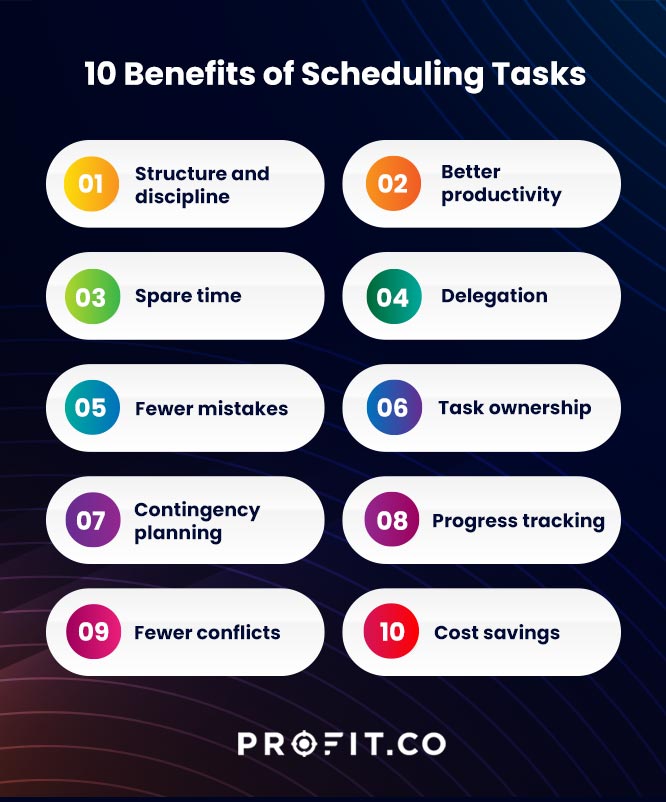Introduction
While no business can achieve 100% productivity, there are plenty of reasons to improve performance through scheduling. For example, highly engaged employees are over 20% more productive at work, given good communication, few distractions, and the right tools to manage their tasks.
Once you understand how to schedule your time, you’ll see daily benefits to your productivity.
This guide discusses the essentials of a schedule, from the components of a schedule to best practices to improve performance, so let’s start with defining a schedule.
What Is A Schedule?
A schedule is a plan that lists down your activities to help you prioritize your time and achieve your goals. In a business context, a schedule outlines an employee’s work days and times. It includes information like working hours and shifts, employee names, and duties or responsibilities for that period.
A work schedule can be a physical document or digital document, or a scheduling app. Every business needs work schedules to manage time and human resources, whether your workforce is full-time, seasonal, or freelance.
Importance of Scheduling and Time Management
When done correctly, scheduling helps you make the most of your available resources. A schedule is important for the following reasons:
- Better Work-Life Balance
Activities like medical appointments, meal planning, family time, and sleep are just as important as our jobs and businesses. Scheduled tasks allow us to plan our lives better, so work priorities don’t interfere with personal responsibilities and vice versa.
- Managing Workload
Scheduling also helps us to take on tasks that we can handle effectively. Otherwise, we may end up with too much on our plates, which leads to increased stress and dissatisfaction.
- Meeting Deadlines
Time is money when delivering to your clients and maintaining good customer relationships. Scheduled tasks can improve efficiency if you consistently miss deadlines or lose leads.
- Steady Progress Towards Your Goals
You can schedule days, weeks, hours, and even years to set short-term and long-term goals. A good schedule also accommodates contingencies to keep you on track with your targets.
- Accountability
Work schedules ensure that everyone on the team receives the correct tasks and time allocation to level the playing field. Transparent work schedules also reassure the team that there’s no favoritism in shift or task allocation.
- Happier Teams
A good schedule encourages collaboration since operations run like clockwork, and every team member plays their part. It also opens communication so teams can adjust their schedules without severely impacting their productivity.
The key is not to prioritize what’s on your schedule, but to schedule your priorities.
Schedules
Types of Schedules
Nowadays, there’s a schedule for every occasion, especially since the Covid-19 pandemic disrupted how businesses and individuals operate worldwide. Here are the main types of schedules:
- Full-time schedule: working 35-40 hours per week
- Part-time schedule: working less than 35 hours per week
- Fixed schedule: set hours per day (9 am to 5 pm)
- Flexible schedule: hours counted from arrival (start at 10 am, end at 6 pm)
- Shift-based schedule: employees take turns to keep a 24-hour business running (morning, afternoon, night shifts)
- Rotating schedule: a shift-based schedule that follows a cyclical pattern (morning shift for two days, night shift for three days)
- Seasonal schedule: work available at specific times of the year (summer, winter, planting, harvest)
- Overtime schedule: extra hours paid 1.5 or 2x the regular rate.
- Compressed schedule: working 35-40 hours over four days instead of 5
- Split schedule: working in sprints followed by breaks (8 am to 12 pm, 2 pm to 6 pm)
- On-call schedule: being available for work whenever necessary, often including outside regular hours
Different businesses and industries use these schedules in their operations. Frontline health care and emergency service workers typically use a combination of shift-based, rotating, and on-call schedules and restaurants often combine full-time, part-time, and overtime schedules.
The world may be changing, but business leaders need a firm handle on project and task management. It becomes easier for teams who use task management software. Software should be agile, easy to implement, and simple to integrate with your other software. Implementing a system like OKRs is well worth the effort and easier to manage with the right solution and support. You can book a free demo with the OKR experts at Profit.co to learn more about how OKRs and task management can go hand in hand to power productivity in your organization.
Components of Your Schedule
- An effective schedule has the following key elements:
- Start time, end time, and breaks
- Days off
- Overtime hours or days in the week (busiest weekdays or weekends)
- Daily, weekly, monthly, and annual working hours
- Weekly and annual holidays
- Shifts and rotations
- Location information
- Team members’ roles and responsibilities during working hours
Of course, you can add other details to your schedule to help your team work effectively.
Benefits of Scheduling
Scheduled tasks help you to accomplish more every day despite distractions and inconveniences. The top benefits of scheduling are:
- Structure and Discipline
A schedule establishes a predictable routine that reduces stress and improves efficiency. It makes decision-making easier, eliminates uncertainties, and builds healthy habits to manage your time and energy better. It can be a part of productivity planning and goal management.
- Better Productivity
Scheduling enables you to prioritize important tasks and identify potential time wasters. Since you can’t add hours to the day, a schedule helps you use the time you have to do the right things better, faster and increase productivity.
- Spare Time
A good schedule is a difference between being constantly overwhelmed and having extra time for your well-being. As you get better at scheduling, you’ll discover time-saving techniques and productivity hacks that translate to:
- Finishing work earlier than expected
- More time for problem-solving
- Adequate breaks for meals and exercise
- Better pace to accomplish scheduled tasks
- Delegation
Scheduling can help you hand over tasks to better-qualified or more experienced team members. For example, a business owner can save time by outsourcing accounting and IT services instead of spending valuable time on these tasks.
- Fewer Mistakes
Human error can lead to costly mistakes, particularly in manual tasks like reading documents and data capture. Suppose you schedule these activities and give ample time and tools to complete them. In that case, you reduce mistakes and spend less time correcting or redoing tasks and improve the quality of work
- Task Ownership
A schedule is a commitment to productivity where each team member agrees to do their share. Each person becomes responsible for their scheduled tasks, which fosters collaboration and a sense of accomplishment.
- Contingency Planning
Creating a schedule involves anticipating the unexpected. A simple example is sick days and time-off requests. Organize your work tasks to accommodate these needs to avoid interfering with your overall business goals.
- Progress Tracking
A schedule makes your goals tangible because you assign time to each task. For example, if you dedicate two hours to updating your business inventory, you can cross that out of your list and move on to the next task. You can also review your tasks after every few months to see if you’re still on track or need to adjust your business growth objectives and schedule accordingly.
- Fewer Conflicts
Scheduling ensures that every team member knows their role, from arrival time to work locations, overtime rates, and procedures for requesting time off. You also reduce the chances of double-scheduling or over-scheduling.
- Cost Savings
Good scheduling means you get more mileage from your time and team because everyone is much more productive. But it also means that you’ll spend less on paying overtime because all scheduled tasks happen in their allocated time.
How To Schedule Your Tasks
Follow the steps below to plan your schedule effectively:
Step 1: Determine a reasonable time frame for your tasks to achieve your goals. Example: Suppose you need extra hours to study a part-time course. In that case, a flexible schedule can allow you to start work early and finish early, then spend evenings studying.
Step 2: Identify essential tasks and responsibilities that drive your success. Example: HR managers must schedule supervision, coaching, and conflict resolution time.
Step 3: Prioritize these tasks to determine what’s urgent or unavoidable, then schedule them when you’re most productive. Example: If you’re most efficient in the morning, schedule the most challenging tasks for the morning hours.
Step 4: Add contingency time in your schedule to deal with emergencies and distractions which may cause you to work too late. Example: Schedule time for travel delays if your job is unpredictable or adventurous, like tour management.
Step 5: Plan the discretionary or unscheduled time after completing your scheduled tasks. Example: If you find a free half-hour in your workday, use this time to evaluate your goals or get a head start on future projects.
Step 6: Assess your schedule if there’s little to no discretionary time left, which may indicate unnecessary tasks in your plan. Example: If there’s no free time left in your day, consider delegating, outsourcing, or automating tasks.
Scheduling Best practices
Scheduling for a team can be daunting, but here are some guidelines to develop practical scheduled tasks.
- Understand your team’s skills, personalities, work habits, physical location, and preferences to match them to the right tasks.
- Break down the workload according to available working hours per week, busiest times of the day, essential tasks, and critical team members needed to accomplish them.
- Note your team’s clock-in and clock-out times to track productivity and overtime hours.
Establish scheduling rules such as:
- Sharing schedule changes in advance
- Compensation for overtime or unplanned schedule changes
- Rest time between shifts
- Have an effective communication system to update your team about scheduling through email, text messages, phone calls, and chat apps
- Share the schedule 7 to 14 days in advance to allow for rescheduling
- Watch out for scheduling mistakes such as double-scheduling, under and over-scheduling, or mismatched task assignments
- Be mindful of the team’s preferences when they request schedule changes or time off through pre-established rules
- Match top players with less-experienced team members to set the pace and inspire good performance in every shift
- Involve your team in scheduling through availability charts, consultation meetings, and feedback channels
- Use scheduling software and templates to improve accuracy and enable easy schedule updates and changes
- Maintain good relationships with workers who can step in on short notice, such as former employees or interviewees who didn’t make the cut. These individuals are a backup for your scheduled team as part of contingency planning.
FAQs
- What is a schedule? A schedule outlines tasks performed in a day, week, month, or year. It allocates time and human resources to scheduled tasks to improve performance.
- What should I include in a schedule? A schedule includes work hours, start and end times, breaks, days off, and overtime.
- What are the common scheduling mistakes? The most common scheduling mistakes are over- and under-scheduling, double-scheduling, and inappropriate scheduling (assigning tasks to unskilled people).
- What are the factors to consider when making a schedule? An effective schedule accommodates the team’s skills, personalities, and preferences. It also outlines requesting schedule changes, overtime compensation, and contingencies.
Conclusion
Scheduling is an effective way to manage two precious resources: people and time. Choose a scheduling system that balances workload and skill to create ideal shifts and teams. Scheduling templates and software make you more efficient at allocating time, tasks, and team members. Finally, scheduling improves business efficiency, time management, work-life balance, and employee satisfaction. Start scheduling and improve your efficiency today.
To learn how Profit.co can help you with your company’s tasks, track them with measurable metrics and keep your team connected, signup with the experts at Profit.co today!





